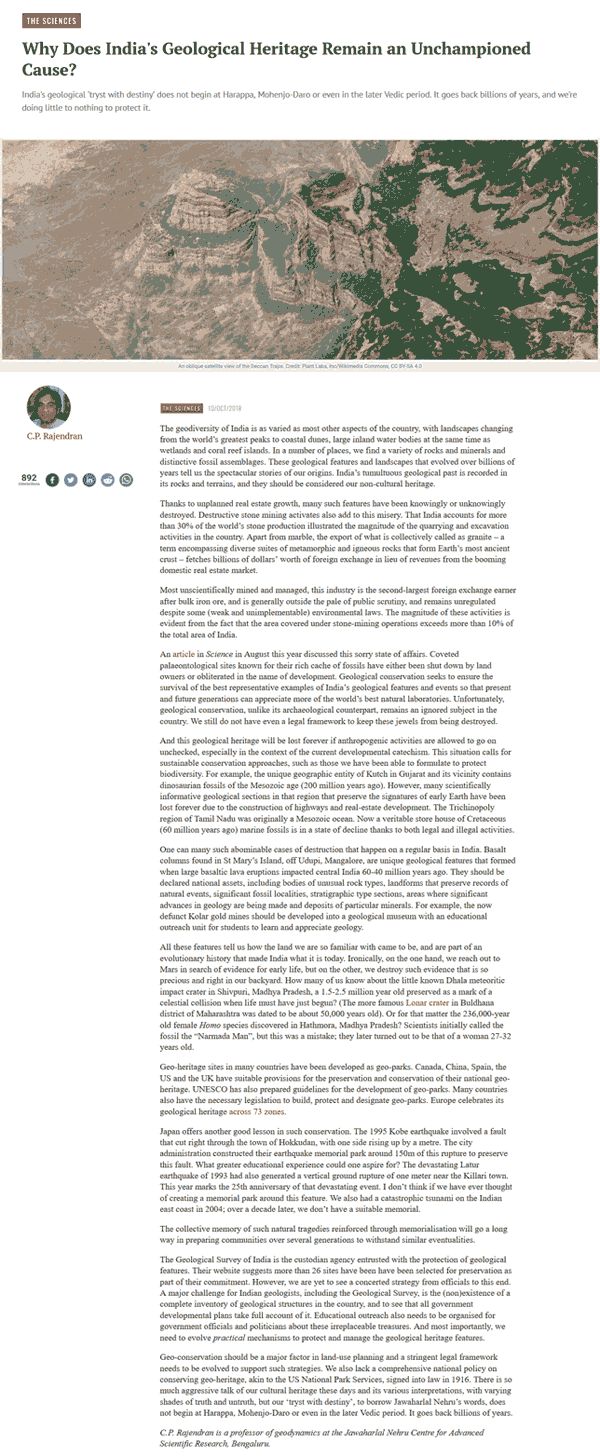Why Does India's Geological Heritage Remain an Unchampioned Cause?
Read article at thewire.in - CLICK HERE

Screenshot Courtesy: https://thewire.in/
A note on the significance of rock sites and the associated biodiversity
- A novel approach by the Society to Save Rocks
By: Prof. R. Pavanaguru
Emeritus Professor
Geology Department
Osmania University
Hyderabad.
Our planet is dynamic and the interactions of lithosphere, hydrosphere and atmosphere producing the geometrical architecture is the reminder of lively and special environment we inhabit from the geological past.
The niceties of the complex features of rock formations and the nature of rocks are marvellous-a science in itself. The dwellers among these abiotic systems are utilising the abnormal carvings and help to sustain the equilibrium of the ecosystem. It is to reiterate that Society to Save Rocks' is belted to locate and protect these architectural forms that have developed as a response to rock deformation and denudation.
Land forms are the geomorphic expressions carved out by nature adhering to the geometric patterns of the rock formations of the earth.(Strahler 1982). The peninsular India which hosts the Deccan plateau is consisting of picturesque land features which have become the sites of biotic life. These rocks are also called as 'unclassified' crystallines due to the non-availability of adequate isotope age data. However, they were assigned 2500 million years of age in Indian stratigraphy.. The holistic study of these forms with various geoscientific inputs particularly in parts of Medak, Ranga Reddy and Mahabubnagar districts of Andhra Pradesh carried out by the Society to Save Rocks has contributed to the ideas on the identification and development of centers of educational, recreational and cultural heritage and associated biodiversity.
Land forms and biodiversity:
Geoscientific features of the landforms were investigated and highlighted by the society to save rocks (Pavanaguru & Vasudeva Rao) in Medak district. The structurally weak planes have produced distinct geomorphic features and are also the potential zones of water bearing horizons. The joint system particularly the vertical and horizontal jointing in granites and the later erosional features have resulted in the present day forms which are not only aesthetic but also harboring important fauna and flora
In Medak district, the area exhibits bouldery and rolling topography. The weathered outcrops yield certain aesthetic forms such as residual hills that include tors and boulders, valley fills, linear dykes, hogbacks and pediment that not only attract the attention of the people but also became the roosting sites of the dwelling fauna and flora.(Pavanaguru et.al. 2000)
No comprehensive studies were so far made on the evaluation of geo-environmental issues and the associated biodiversity and its bearing on the ecology. The importance of landforms as potential sites for environmental protection and conservation of biodiversity in parts of Medak district has been carried out. In this process, over 12000 Sq.Km. area was covered and selected 13 sites comprising distinct geologically controlled landforms with evaluation of the associated fauna and flora, which are both characteristic and abundant was done.
The area is open land with agricultural tracts and open waste interrupted by open scrub and dry deciduous forest. The floral diversity is represented 175 species of scrub, woody and seasonal herbs and shrubs. These sites are also well represented by both common and rare herbal medicinal plants. The floristic elements accompanied by rock formations are recorded.
The macro-faunal diversity is classified as herpetilians (including amphibia and reptiles), the aves and mammals. The aves were represented by 204 species with 17 orders and 49 families, while the mammals were represented by 40 species with 21 families and 6 orders. The amphibia and reptilia consists of 27 species representing 14 families and belonging to 4 orders. All the fauna predominantly utilize these rock sites for various day to day activities.
To mention a few, the best such sites are recorded are at Medak, Rangareddy and Mahbubunagar district were studied.. The significant major structural controls are recorded along NNEE-SSW, NNW-SSE, N-S trending joint sets.
Ripley (1982) recorded a variety of birds (2094) belonging to 1200 species and 400 genera from the Indian subcontinent including India. Of these 318 species belonging to 146 genera are found in Indian wet lands (Vijayan, 1987). In the state of Andhra Pradesh about 450 species representing 58 families were recorded (Taher & Pittie 1989). Other Ave fauna studies in the state have been carried out( Ali 1933 a, Majumdar 1981, Abdul Ali & Mathew 1962 and Ripley 1988 a). All these studies are mainly restricted to coastal regions as well as forest tracts (Vasudeva Rao et. al. 1996 & Nagulu et. al. 1987). But no studies have been made in detail on rock sites and their associated habitat. Hence, in the present study, supported by the Society to Save Rocks, an attempt has been made to evaluate systematic list of macro fauna and flora in parts of Medak district of Andhra Pradesh where the unclassified crystallines are well exposed.
|

